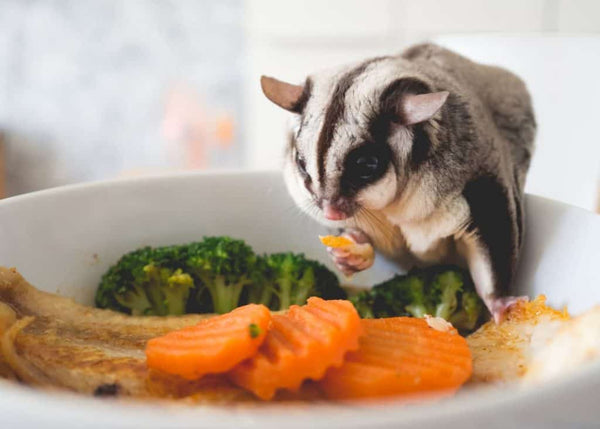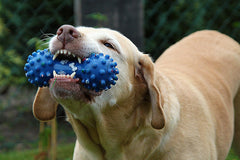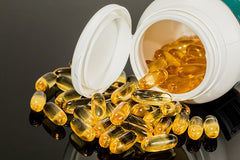
Sugar Gliders have become a popular pet over the past decade or so. Unfortunately, some people think they make for a great first pet and have gone out to adopt a Sugar Glider without realizing how high maintenance this little creature is, until they take it home or do a little more research on their care.
One of the biggest and most important pet care points with the Sugar Glider is their diet. As their name implies, they love sugar and would eat sweet foods all day. However, as we all know, sugar is not what makes up a balanced diet. It’s important to know about the proper Sugar Glider diet as well as other aspects of Sugar Glider care before adopting.
What Should I Feed my Sugar Glider?

Sugar Glider’s diet is very particular. They require at least 25% of their food to be good sources of protein. Protein-rich foods that are good for a Sugar Glider include cooked lean meats and poultry, without any spices or herbs added. Other sources of protein include various dairy products such as yogurt, cheeses, and hard-boiled eggs.
Dry cat food or dog kibble are also good options for foods that contain good proteins for your Sugar Glider. Live insects are another Sugar Glider favorite that contains protein and many other good nutrients. However, live insects should only be given as an occasional treat due to the high-fat content within them. Nuts also make great Sugar Glider treats on occasion, for the same reason as live insects.
Unlike feline nutrition which relies mainly on animal products, sugar gliders would benefit in having a good portion of fruits and vegetables in their meals. Being that Sugar Gliders can’t get enough of the sweet stuff, some good vegetable and fruit choices include apples, sweet corn, bananas, avocados, peaches, pineapples, as well as many other choices. The fruits and vegetables that you give your sugar glider should be fresh each time you feed them rather than canned. Canned fruits and vegetables often have additives such as sugar or syrup added.
Watch their Calcium and Phosphorus Intake Closely

Calcium and phosphorus live inversely inside of a living being's body. This includes Sugar Gliders who are very sensitive to fluctuations in the calcium to phosphorus ratios within their bodies. If they are running too low on calcium and have more phosphorus, relatively, that phosphorus will begin to leach the calcium out of their little ones. Leaving them with brittle bones, among other problems that can occur.
The best ratio for calcium to phosphorus to stick by for your Sugar Glider is a 1-2:1 ratio for their intake of these two important minerals. Sugar Gliders are known to be picky eaters at times. Meaning, if you find that they are not eating enough calcium or phosphorus-containing foods, you should be sure to supplement the minerals somehow. Often here are additives you can add to the meals that they like that contain the missing nutrient. Just be sure to speak with your Sugar Glider’s vet before making any drastic changes in their diet.
What Should I NOT Feed my Sugar Glider?

No matter how irresistible their big round eyes are, you can’t let them sway you into giving them extra-sugary treats that aren’t fruits, vegetables, or dairy products. Foods that you should never feed your Sugar Glider includes foods that contain sugar substitutes, chocolate, or any sort of candy. It's likely that your Sugar Glider would love eating any of these foods, but it would not be good for their physical health.
What Should My Sugar Glider’s Cage Include?
Just like how you puppy-proof a home, you also need to make sure that your home is ready for your sugar glider. In order for your Sugar Glider to feel safe and secure in their new home environment, there are a few things that you will want to make sure are in place before you move them in or expect them to feel at home. As far as the size of the cage you should provide, the bigger the better. Sugar Gliders love to climb and move around, so it’s important that you provide that for them.
Sugar Gliders love to play, so the more toys you can give them, the better. Some of the best and more preferred Sugar Glider toys include chew toys, latters, tunnels, and even some bird toys. It's important they are given stimulating toys to help keep them active as well as stimulated throughout the day or night.
Whether your pet is a sugar glider or common house pets like the cat and dog, you need to provide them with chew toys and other play things.
Conclusion
A Sugar Glider's diet is rather complex and takes a lot of patience as well as attention. The variety of food that they are able to eat is rather broad within the realm of fruits and vegetables. Certain dairy products as well as live insects on occasion are also great choices for adding protein into their diets.
Because of this complexity to their dietary needs, owning a Sugar Glider is not for someone who is not ready for such a responsibility. However, for someone who is ready and able to take on such a task, the Sugar Glider makes a great companion for someone who is looking for a pet that is outside the norm.
What do sugar gliders eat?
How to care for a sugar glider?
Where to get a sugar glider?
Check out our blog and follow me on LinkedIn to stay up-to-date!




